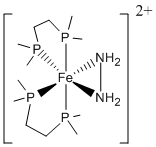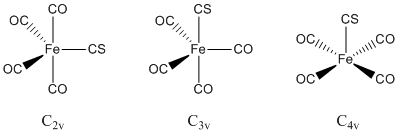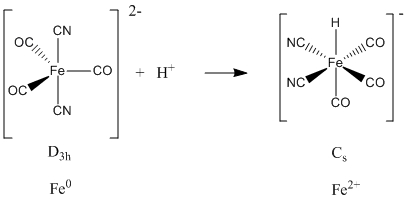Chemistry 401
Intermediate Inorganic Chemistry
University of Rhode Island
Fall 2009
Final Exam
All references are to volume 48 of Inorganic Chemistry (2009)
1. Field, Li, and Magill (pages 5 – 7) studied the reactivity of [Fe(dmpe)2(NH2NH2)]2+ (dmpe = 1,2-bis(dimethylphosphino)ethane), shown below. Find the point group for the complex. Reaction with a strong base deprotonates one hydrogen atom from each nitrogen of the hydrazine ligand. The product can be viewed either as an azene (HN=NH) ligand or as a dianionic hydrazido (NHNH2–) ligand. Consider each case: what is the oxidation state of the Fe and what is the LFSE? Could the two different representations be distinguished using uv-vis spectroscopy? If yes, how? If no, why not?
Point Group: C2
The acid-base reaction is: [Fe(dmpe)2(NH2NH2)]2+ + 2 B → [Fe(dmpe)2(NHNH)] + 2 HB+
If the NHNH ligand is considered an azene, NH=NH, then the Fe is Fe0, which is d8, t2g6eg2, with LFSE = –12Dq. If the NHNH ligand is considered a dihydrazide, NHNH2–, then the Fe is Fe2+, which is d6, t2g6 in a strong field, with LFSE = 24Dq – 2P.
Spectroscopically, the t2g6eg2 and t2g6 electron configurations should be distinguishable. However, the spectrum is likely to be dominated by charge-transfer transitions (because of the two oxidation states of the NHNH ligand) that would obscure the d-d transitions.
2. Haynes, Meijer, Lyons, and Adams (pages 28 – 35) examined the cis, mer isomer of [IrI3(CO)2Me]– (Me = methyl). Draw the structure and give the point group. Is the complex expected to be stable by the EAN rule? Why or why not?
The structure is
, which has point group Cs.
Ir3+ is d6, each I– contribute 2 electrons, each CO contributes 2 electrons, and CH3– contributes 2 electrons. The total electron count is 6 + 3(2) + 2(2) + 2 = 18, so the complex is expected to be stable.
3. Dethlefsen, Hedegård, Rimmer, Ford, and Døssing (pages 231 – 238) performed photochemical studies on the complex [Cr(NCCH3))5)(NS)]2+) (assume that the CrNS fragment is linear). Find the point group of the complex (ignore the hydrogen atoms). Photolysis causes the nitrogen monosulfide ligand to be released. Write the Lewis Dot structure for NS and find the formal charges and oxidation state on each atom. Do you think that the assumption that the CrNS fragment is linear is a good assumption? Why or why not?
The structure of the complex is
and the point group is C4v.
The Lewis Dot structure for NS is
. The formal charges on both N and S are 0. The oxidation state of N is –2 and the oxidation state of S is +2.
The N atom bonded to the Cr has an extra electron that may not be involved in donation to the metal. This extra electron might be stereochemically active, causing a slight bend. However, since it is not a full electron pair, the bend may be small.
4. Wu, Kroll, and Dias (pages 423 – 425) determined the crystal structure of chloro(η2-3-hexynegold(I). Draw the structure and find the point group. What drives the stability of this complex?
The structure is
with point group C2v.
Au+ is d10 so the LFSE = 0. Using the EAN rule gives an electron count of 10 + 2 (Cl–) + 2 (η2-3-hexyne) = 14, which is not expected to be stable. If the second pair of electrons from the hexyne π bond can contribute to the electron count, then the total electron count is 16, which is often stable. Backbonding from the gold to the hexyne π* orbitals may also contribute to the stability.
5. Zimmerman, Paul, Zhang, and Musgrave (pages 1069 – 1081) used ab initio calculations to study NH2BH2. Write the Lewis Dot structure for this compound using both the minimum formal charge rule and the octet rule, estimate all of the bond angles for each representation, and give the point group for each representation. NH2BH2 reacts readily at room temperature and can only be isolated at cryogenic conditions. Which dot structure is more consistent with this observation? Explain why.
The Lewis Dot structures are:
For the minimum formal charge structure all atoms have 0 formal charge, the point group is Cs, and the bond angles are: H-N-H, ~107°; H-N-B, ~107°; N-B-H, 120°; and H-B-H, 120°.
For the octet rule structure the N atom has a formal charge of +1, the B atom has a formal charge of –1, and all H atoms have formal charges of 0, the point group is C2v, and the bond angles are: H-N-H, ~120°; H-N-B, ~120°; N-B-H, 120°; and H-B-H, 120°.
The highly reactive nature of NH2BH2 suggests that the double bonded, octet rule structure is predominant: double bonds are typically more reactive than single bonds.
6. Johns, Chmely, and Hanusa (pages 1380 – 1384) synthesized Ca[N(SiMe3)2]2 (Me = methyl), which is an ionic compound. Draw the Lewis Dot structure for the anion and give the point group. Which ion will form the lattice and which ion will fill the holes. Explain why.
The Lewis structure for the anion is
with point group C2v
The anion is much larger than the cation so the anion will form the lattice and the calcium ion will fill the holes. Since the anion is not spherical, it may not be a closest-packed lattice.
7. Rogow, Swanson, Oliver, and Oliver (pages1533 – 1541) investigated the properties of (NH4)[Gd(CO3)2(H2O)]. Write the electron configuration for the gadolinium ion in this compound, give the term symbol for the electron configuration, and predict the spin-only magnetic moment. The observed magnetic moment is 3.02 μB. Explain any differences between the observed magnetic moment and the predicted magnetic moment.
Gd3+ has electron configuration [Xe]4f7. L = 0 and S = 7/2 so the term symbol is 8S. There are 7 unpaired electrons so the predicted magnetic moment is [7(7+2)]½ = [63]½ = 7.94 μB.
The predicted and observed magnetic moments do not match. This is likely due to the fact that lanthanides often have a significant orbital contribution to the magnetic moment that the spin-only formula does not account for. In this case since L = 0, it is hard to predict that the orbital moment can contribute, however. Antiferromagnetism is a more likely possibility for the low moment.
8. Derossi, Brammer, Hunter, and Ward (pages 1666 – 1677) prepared [Ru(bpy)(CN)4]2– and studied its interactions with various cations. Write the structure, find the point group, determine the LFSE, predict the magnetic moment, and give the systematic name of the ion.
The structure is
with point group C2v.
Ru2+ is d6 in a strong field, t2g6, so the LFSE = 24Dq – 2P with 0 unpaired spins and μ = 0 μB.
The systematic name for the anion is 2,2'-bipyridinetetracyanoruthenate(II).
9. Zhang, Li, Xie, King, and Schaefer (pages 1974 – 1988) found that three isomers of Fe(CO)4(CS) lie close in energy (for linear Fe-C-X bonds, X = O, S). These isomers have point groups C2v, C3v, and C4v. Draw the structures and predict which is likely to be the most stable. Explain your reasoning.
The structures are:
The electron count is the same in each complex so stability can not be decided by the EAN rule. The CS ligand is larger than the CO ligand, so CS should prefer to be in the least sterically hindered site, which is the equatorial plane of the trigonal bipyramid structure, i.e. the C2v structure. Since the S atom is remote from the Fe center atom, the C3v structure is expected to be close in energy. The C4v structure must be higher in energy because of the larger number of 90° repulsions between ligands. The calculations that the group performed found that the C2v and C3v structures are effectively indistinguishable in energy (within the limitations of the model) and that the C4v structure is higher in energy.
10. Whaley, Rauchfuss, and Wilson (pages 4462 – 4469) suggested that the metal hydride [FeH(CN)2(CO)3]– could be used as a model compound for the active site in [NiFe]-hydrogenase, an enzyme used to reduce dihydrogen to hydrogen ions. fac-[FeH(CN)2(CO)3]– is prepared by adding a strong acid to D3h [Fe(CN)2(CO)3]2–. Write the acid/base reaction (showing structures of both complexes), find the point group for the product complex, and explain how adding a hydrogen ion to the reactant leads to a hydride product.
The reaction is:
The point group of the product is Cs
Addition of the hydrogen ion, H+, is accompanied by an internal oxidation-reduction reaction: the Fe atom is oxidized from 0 to +2 while the H atom is reduced from +1 to –1.




